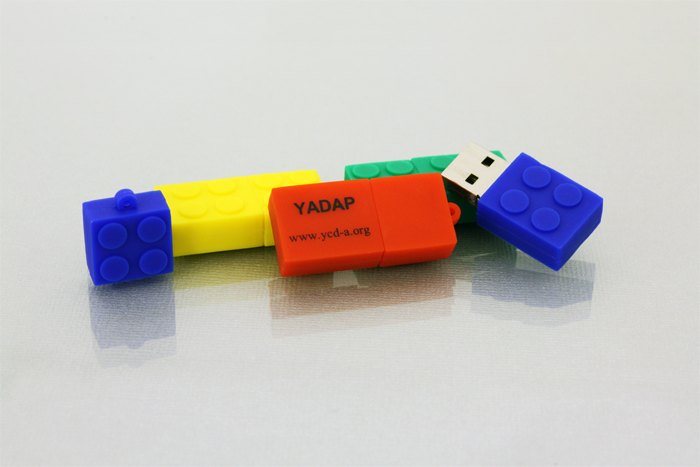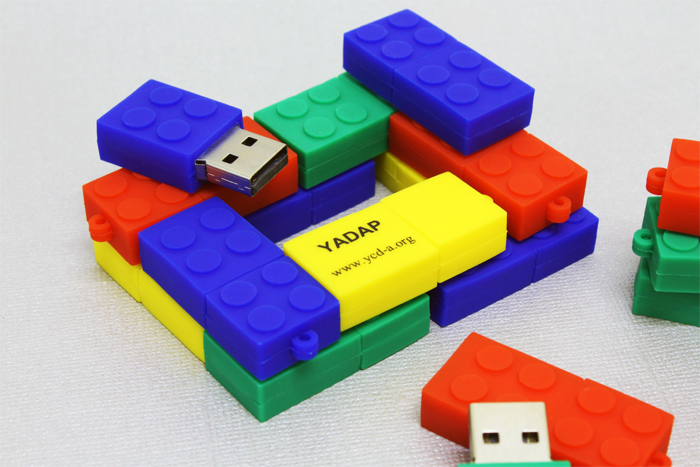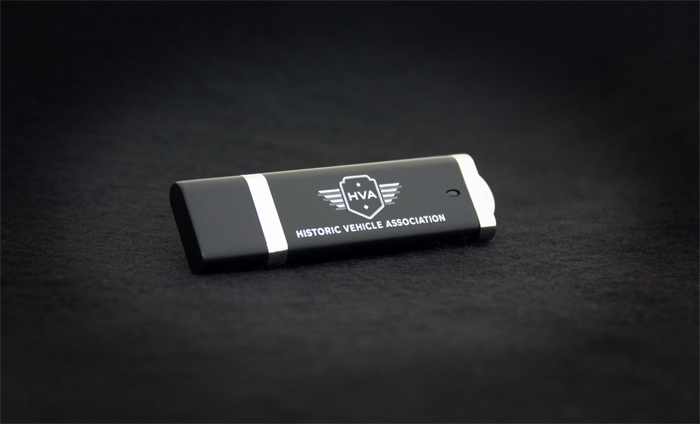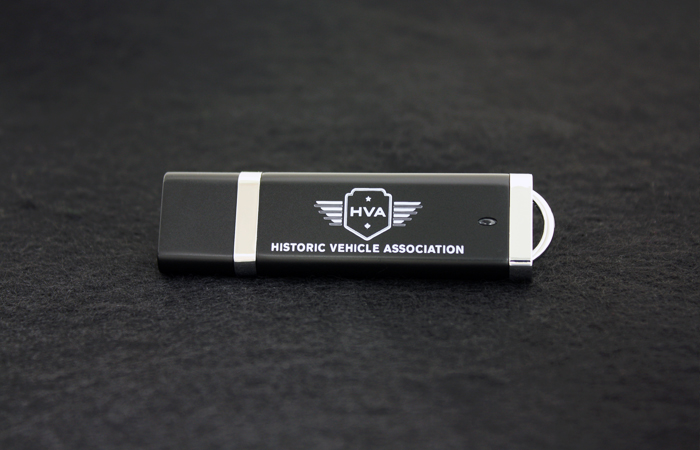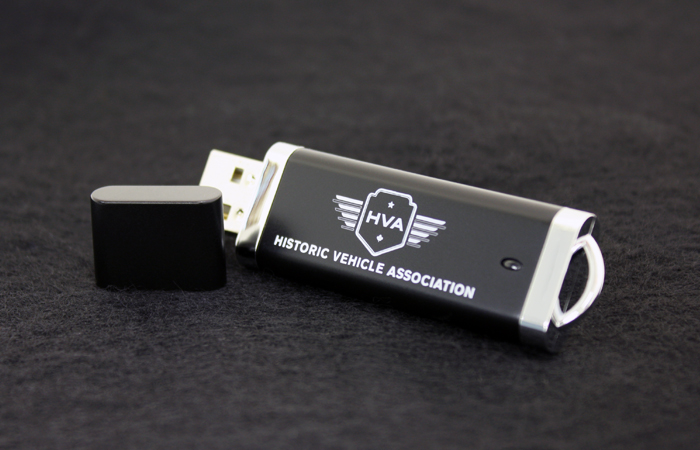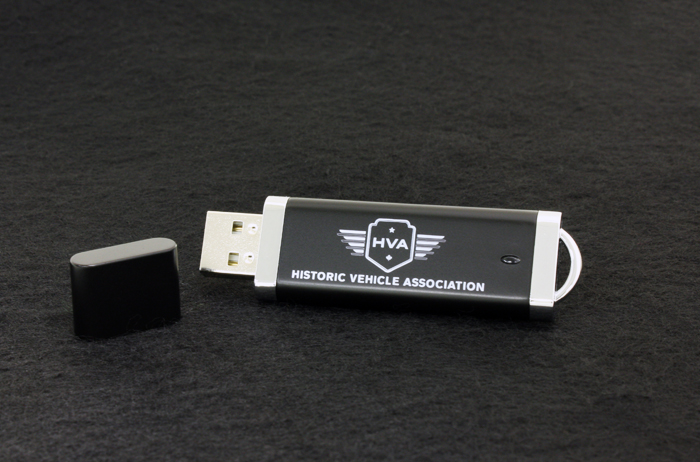We got a cool batch of drives made up for an organization who wanted to get a Lego shaped USB. They where made from our rubberized material. We can mold drives from any materials so technically these could have been exact Lego copies with the addition of a USB. If anyone wants some hard plastic Lego drives let us know, I’m overly eager to build another fort. Or for that matter if you would like a custom shape made from any type of material, please contact us as well.
Finally I am back doing what I enjoy most, taking pictures and rambling! To kick things off I decided to take some pictures of HVA’s order, Historical Auto Association, ’cause who doesn’t like a nice classic car. They got the matte body style not the high gloss and it came out great. You might have also noticed I tweaked the layout slightly. Since I’ve gotten better at taking photos I don’t need to shrink them as much to hide all my mistakes, so hello large format 🙂
So that was the DE Matte Black. You can see this style here.
A secret about the background I used to photograph these USB drives. It can from a laptop I had order, the screen was protect by this black fabric material. Turns out it makes a cool background for images.
Thank you for reading.
-Nick
Name Online is a an organization that promotes wellness in marriages though couples counseling and spiritual services. Recently they placed orders for these custom printed flash drives with matching windowed tin. These flash drives are durable with epoxy resin coating and a key loop for easy carrying and storage.
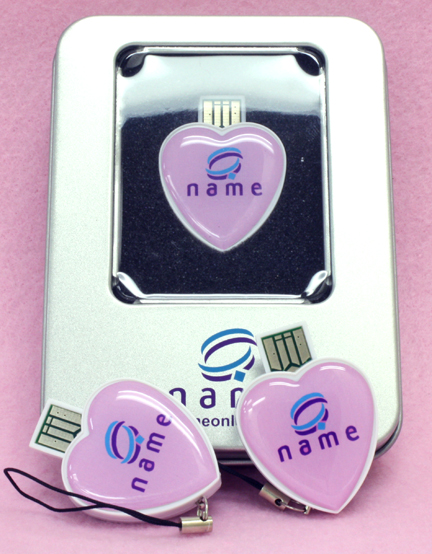
Name Online Custom Printed USB Drives with Matching Tin
This guide will explain the steps to install Ubuntu Linux 10.04 Desktop Edition to a flash drive. There are three options to explore: Live USB, Persistent Live USB, and direct install to USB. We will cover the necessary steps to accomplish each type of install.
Option 1: Boot Ubuntu as a Live CD from a USB Flash Drive
Use this option to install Ubuntu as a Live Install, which allows you to boot from the USB flash drive in Ubuntu, experience the Linux environment but will not retain any changes or settings after you shut down. This is a great way to get a feel for the OS, test some of it’s capabilities as well as typical hardware compatibility.
What you will need:
Running Windows XP/Vista/7
Fat32 Formatted USB 2.0 Flash Drive, at least 1GB
PC with a Bios that can boot from USB
Now with all of the necessary components in place, we can begin to setup our Ubuntu Live USB Drive.
1. Run the Universal USB Installer by Pendrivelinux.com that you downloaded earlier.
2. Choose Ubuntu 9.10/10.04.1 Desktop i386
3. Select the Ubuntu Live CD that you downloaded earlier
4. Choose your Flash Drive
5. In this instance, we are going leave the persistence option unchecked.

This can take anywhere from 15 minutes to 30 minutes depending on the speed of your system. At one point the progress bar will freeze until it is done, and this is the lengthiest wait of the process.
Once complete, you can reboot your computer with the USB flash drive in the USB port, press F12 for the Boot Menu and choose the removable media to boot from and you are in.
As this is a Live USB, any changes you make to the Ubuntu environment will not persist through a reboot. This is because running in this mode, Ubuntu uses available RAM in place of Swap and Hard Disk space. This option also contains the install files needed to install Ubuntu directly to your desktop if you should so desire.
Option 2: Boot Ubuntu as a Live CD with Persistence from a USB Flash Drive
This option will install Ubuntu Linux onto your flash drive with an area for persistent storage. You will be able to restart the computer, boot back into the Linux environment and all settings or changes made previously will persist.
NOTE: This option is particularly hard on Flash Memory, as there can be quite a bit of reading and writing to the Flash Memory.
What you will need:
Running Windows XP/Vista/7
Fat32 Formatted USB 2.0 Flash Drive, at least 2GB
PC with a Bios that can boot from USB
Now with all of the necessary components in place, we can begin to setup our Ubuntu Live USB Drive.
1. Run the Universal USB Installer by Pendrivelinux.com that you downloaded earlier.
2. Choose Ubuntu 9.10/10.04.1 Desktop i386
3. Select the Ubuntu Live CD that you downloaded earlier
4. Choose your Flash Drive
5. Select the Persistence Option of 1GB Casper-RW

This can take anywhere from 15 minutes to 30 minutes depending on the speed of your system. At one point the progress bar will freeze until it is done, and this is the lengthiest wait of the process.
Once complete, you can reboot your computer with the USB flash drive in the USB port, press F12 for the Boot Menu and choose the removable media to boot from and you are in.
As this is a Live USB with Persistence, any changes you make to the Ubuntu environment will keep through a reboot. This option also contains the install files needed to install Ubuntu directly to your desktop if you should so desire.
Option 3: Install Ubuntu directly to a USB flash Drive
This option works through installing Ubuntu to the flash drive as a complete installation. It does not retain the installation files to install on another system. This will allow you to use Ubuntu exactly as if it were installed alone on the hard disk. You can boot from it with any computer that can boot from a USB flash drive.
Note: This method requires that you disable your hard drive in BIOS to prevent overwriting your current operating system and force the install onto the USB drive.
What you will need:
USB 2.0 Flash Drive, at least 4GB
PC with a BIOS that can boot from USB
Blank CD
A Computer with the ability to Burn CD/DVD
Now with all of the necessary components in place, we can begin the process.
1. First, you will need to burn your Ubuntu ISO to CD using a program like ImgBurn.
2. Boot your computer and press F2 to enter the system BIOS. Within here you will want to disable your Hard Drive. If this is not an option in your BIOS, I would suggest shutting down your computer and unplugging the power and data cables from your hard drive before proceeding. NOTE: If you choose not to disable your hard drive, you run the risk of installing Ubuntu on top of your current OS and can lose valuable information.
3. After you have disabled your hard drive, place the Ubuntu Live CD into your computer and boot from this.
4. At the initial boot screen, choose to try Ubuntu, not install.
5. Once Ubuntu loads, plug in the desired flash drive into the computer.
6. Now, double click on the Install Ubuntu icon that appears on the desktop.
7. The first 3 screens are language, time zone, and keyboard layout.
8. Now Ubuntu will notify you that there is a disk mounted, and asks to unmount it. This is your flash drive. Give it permission to unmount.
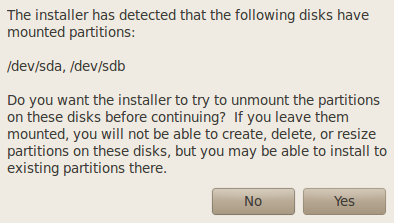
9. This is the prepare disk space screen. I chose to leave mine at default and let the installer handle the partitions needed by Linux.
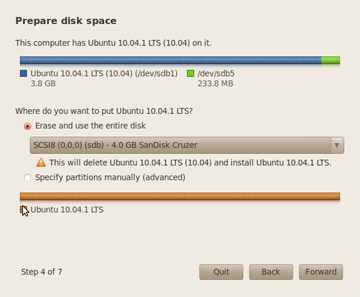
10. Now you will see the login and user information screen.

11. Now you are ready to install, click install.
12. At one point during the installation, you may notice a skip button appear on the bottom left. This is to skip the auto update, and finally the language packs. I chose to skip language packs update.

13. This may take a while, mine took atbout 35 minutes to complete. When it is done, eject the disk and shut down the computer. Plug your hard drive back in if necessary, or boot your computer into bios and re-enable it. Reboot your computer and press F12 to enter the boot menu, choose the flash drive and boot into Ubuntu.
Thank you for joining us for this How To Guide. Check back often for new posts.
Kraft Power recently came to us to create this very interesting USB flash drive. This custom shaped drive represents what what they do best. Kraft Power is a provider of diesel and gas engines, parts and accessories as well as generator power systems and power transmission systems.
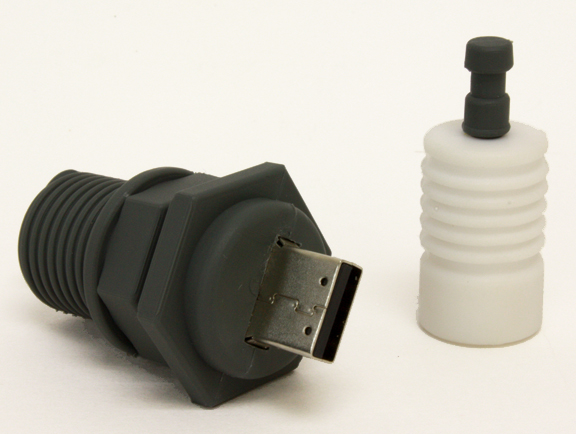
Kraft Power Custom Shaped USB Drives
This guide is written to help an administrator block the access of USB storage devices like USB flash drives in Windows XP. This is particularly useful for large offices who work in sensitive information, like the Health Care industry.
Setting User Permissions
1. Log into an Administrator account in the desired Windows computer.
2. Open up a Windows Explorer window, and in the address field type:
%SystemRoot%\Inf
3. Locate the files Usbstor.inf and Usbstor.pnf, select both files, right-click and go to Properties.

usbstor.inf and usbstor.png files in windows inf folder
4. Click on the Security Tab.

Security Tab in the Properties Panel
5. In the Group or User Names list, add the user group that you want to deny permissions to.
6. In the Permissions for that group, click the Deny box next to Full Control.
7. Now repeat step 6 for the System Account.
This will prevent any new access to a USB storage device, but if a device is already installed on the computer you will need to complete these additional steps.
These steps require that you modify the registry. This can cause serious problems if you modify incorrectly. You should begin by creating a backup of your registry. This can be restored in the event that you incorrectly modify and cause an error in Windows.
Backing Up The Registry
1. Click Start, Run, and type:
%SystemRoot%\system32\restore\rstrui.exe
2. Click OK.
3. On the Welcome to System Restore page, click Create a Restore Point and click Next.
4. On the Create a Restore Point page, type a name for the Restore Point and then click Create. -if you have restores turned off it will ask whether to turn on now, click yes, in the System Properties dialog box, clear the Turn off System Restore check box and click OK.
5. After the restore is created click close.
Changing the Registry
1. Click on Start, Run and type:
regedit
2. CLick OK.
3. Locate and click the following Registry Key:
HKEY_LOCAL_MACHINE\SYSTEM\CurrentControlSet\Services\UsbStor

Registry Entry for USBStor
4. In the details area, double–click Start.
5. In the Value data box, type 4, click Hexadecimal (if it is not already selected).
6. Click OK.
7. Exit the Registry Editor.
Now the system should be locked from using USB storage devices. Plug in a USB drive and you will see that it will not load. You can check that it does register in the Device Manager but is not permitted to load drivers.
Verifying in Device Manager
1. Click on Start, then Right–click My Computer and choose Properties.
2. Click on the Hardware tab.
3. Click Device Manager.
4. Listed under Universal Serial Bus Controllers, there should be a device with an exclamation mark. This would be the USB drive with blocked drivers.
Restoring The Registry (ONLY use this if you have incorrectly altered the Registry)
Do not use this to reverse the above effects at a later date, as restoring to this date will undo any adjustments in windows between these dates.
1. Click Start, Run and type:
%SystemRoot%\System32\Restore\Rstrui.exe
2. Click OK.
3. On the Welcome to System Restore page, click Restore My Computer to an Earlier Time and click Next.
4. On the Select A Restore Point page, click the system checkpoint you recently created. In the On This List Select the Restore Point area, click “Guided Help (Registry Backup)” and click Next.
5. A system message may appear that list configuration changes to be made, click OK.
6. Confirm Restore Point Selection, Click Next.
7. Windows will restart, click OK on the confirmation.
Thanks for joining me on another How-to instruction.
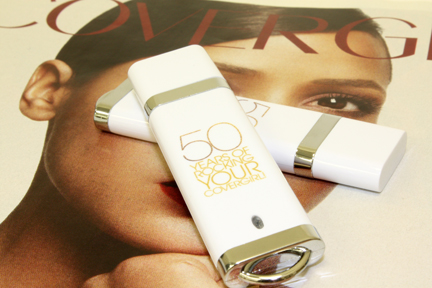
CoverGirl Custom USB Drives
This order of custom USB drives we created for Covergirl Makeup were made using a full color print so they appear like the words were written in shimmering gold. They chose the DE style because of its simple design and large logo area and the swift production offered with these flash drives.
Recently there have been quite a few requests for our new key styles of custom USB drives. These styles have the look and feel of house keys, while offering a sturdy and reliable way to carry your data. This particular order of Key style flash drives really shows what a company can do with their logo. Matching the logo and lanyard colors makes these drives look truly customized.
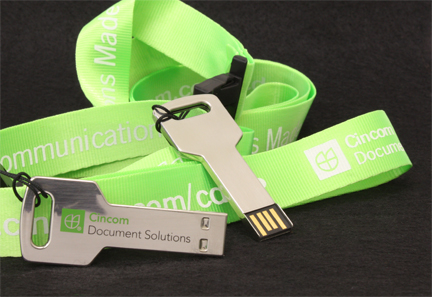
Cincom Key Style USB with Lanyard
Not only were they able to print the logo and company name, but also the mission of the company around the lanyard. Cincom Systems, Inc. is a company that specializes in reducing the costs of operations through intelligent document automation.
We recently created these very unique USB flash drives for Applied Forensics. These ultra sturdy drives have an added use, they dual as a bottle opener. It helps to symbolize Applied Forensics, who specialize in document and handwriting forensics. These drives also have a convenient key loop so that you can keep your data available with you always.
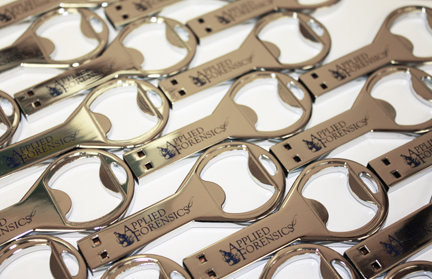
These USB drives are sturdy and multifuntional.
These Airworks Compressors SWM style custom USB drives have an added touch. We received this order with a request to print the logo with Pantone colors as well as create two matching drives with the Pantone colors. As you can see, these drives look great. Airworks Compressors offer state-of-the-art mobile air compressor systems, hydraulic power paks, as well as auxiliary power systems.
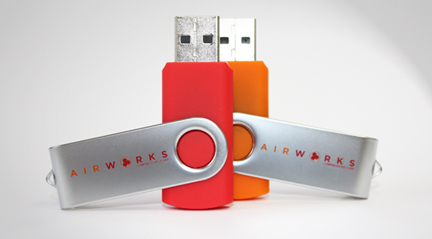
These custom USB drives were color matched using the Pantone system.

